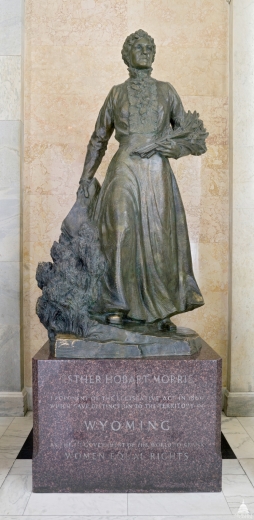
Explore Capitol Hill
Bronze
Given by Wyoming in 1960
Hall of Columns
U.S. Capitol
This statue of Esther Hobart Morris was given to the National Statuary Hall Collection by Wyoming in 1960. Morris is honored as a pioneer for women's suffrage.
Woman suffrage leader Esther Hobart Morris was born in Tioga County, New York, on August 8, 1814. Orphaned at age 11, she was apprenticed to a seamstress and became a successful milliner and businesswoman. As a young woman she was active in the anti-slavery movement. Widowed in 1845, she moved to Peru, Illinois, to settle the property in her husband's estate. There she realized the legal difficulties faced by women. She married John Morris, a prosperous merchant, and in 1869 they moved to a gold rush camp at South Pass City, Wyoming Territory.
To promote the idea of giving women the right to vote, Morris organized a tea party for the electors and candidates for the first territorial legislature. With the national woman suffrage movement still being organized, Wyoming's enactment of such a law in 1869 was a legislative milestone. Laws were also passed giving married women control of their own property and providing equal pay for women teachers.
When appointed justice of the peace for the South Pass District in 1870, she became the first woman to hold judicial office in the modern world. During the statehood celebration in 1890 she was honored as a suffrage pioneer. In 1895, at age 80, she was elected a delegate to the national suffrage convention in Cleveland. She died in Cheyenne on April 2, 1902.









